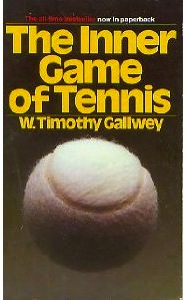The Inner Game and software development
A few years ago I heard a story on ESPN about Pete Carroll, when he was still the head coach at USC. The reporter talked about a book Coach Carroll had his players read. What interested me about this was that the book, W. Timothy Gallwey’s The Inner Game of Tennis: The Classic Guide to the Mental Side of Peak Performance, isn’t even about football. Intrigued by that, and the fact that USC’s success at the time indicated that maybe it at least couldn’t hurt to check this book out sometime, I picked up a used copy (so used that my copy doesn’t include the word classic in the title yet). I finally got around to reading it this past month.

I don’t play tennis. The only sport I even dabble in anymore is bowling, and I haven’t done that in a month. However, as Coach Carroll found, The Inner Game of Tennis transcends tennis. It transcends sport (indeed, Gallwey also offers The Inner Game of Work; I haven’t read it yet). There are some good pearls for software developers in the book, if you allow yourself to read between the lines a bit. Here are few takeaways I got:
Set your subconscious free: The crux ofThe Inner Game is that we have two “selfs;” one conscious and one subconscious. The conscious self, often, serves as critic, when it would do better as an observer of the subconscious self, which is responsible for learning, creativity, and productivity. By acknowledging this, and working with the conscious self to not be judgmental, can the code we write as developers become art?
Observe and report: Gallwey suggests the utility of video in learning to observe. He wrote this in a day before video cameras were as ubiquitous as they’ve become. I wonder if there’s something to be said for developers recording screencasts of their work, talking through their thought processes; then reviewing the recording later, to practice the skill of impartial observation. Has anybody tried this?
Learn from the pros: I found Gallwey’s assertion that watching elite tennis players do their thing on television will improve one’s game especially interesting. When he wrote the book, tennis fans had roughly one day a week to sit down and watch tennis from the couch; now there are multiple 24-hour sports channels that may show tennis at any given time. There’s even a channel dedicated to tennis.
Bringing this back to software development: I’ve always been a big proponent of watching quality screencasts like Railscasts, even if you’ll never have a need for the topic covered in a given week’s episode. The fact is Ryan Bates, the developer behind Railscasts, is a top-notch Rails developer, and his everyday coding habits are the kinds of best practices all Rails developers should follow. I’m not talking about the old learning through osmosis joke. You still have to watch, and you still have to pay attention. But again, our video-everywhere society makes it easier to access these pros and learn from the best.
Know the game: What is the reason one picks up a tennis racket? Or plays any game, for that matter? Gallwey’s list of inner motivations is fascinating, especially when you realize that your actual motivation may not be what you think. To be honest, I’m still sorting this out how this applies outside of sports, particularly to software development. I hope to gain more insight after reading The Inner Game of Work, but I think one could eventually write a list of “inner games” that differentiate the programming theorists, the script kiddies, and the people who want to turn in a quality project as efficiently as possible.
The Inner Game of Tennis may get a little too metaphysical in spots for some people, and some may gloss over the chapters that are heavier on tennis technique than discussion of the Inner Game. It’s a quick read, however, and a good opportunity to take a break from books about coding or management. I should note that some follow-up research revealed that at least one other developer has read and reported on the book; you may find his notes to be useful as well; they’re a little more thorough than mine.
. Questions or comments? Let me know what you think.